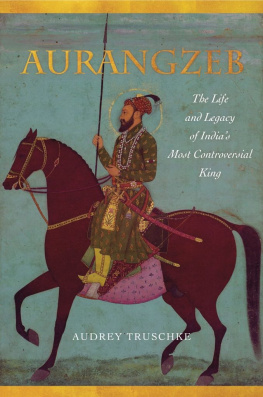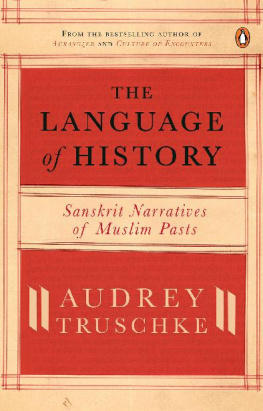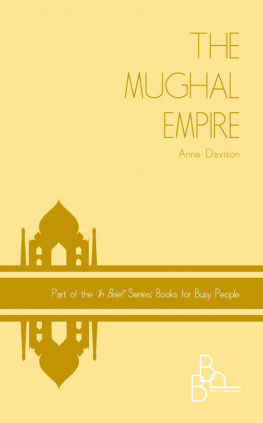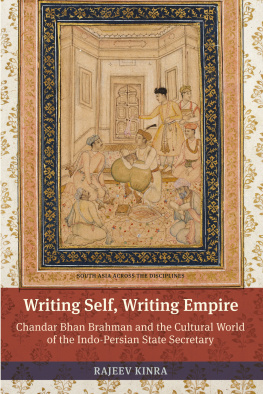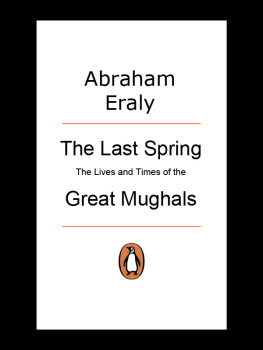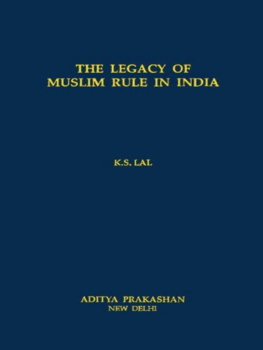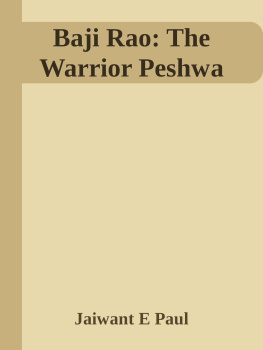Stanford University Press
Stanford, California
2017 by the Board of Trustees of the Leland Stanford Junior University.
All rights reserved.
No part of this book may be reproduced or transmitted in any form or by any means, electronic or mechanical, including photocopying and recording, or in any information storage or retrieval system without the prior written permission of Stanford University Press.
Printed in the United States of America on acid-free, archival-quality paper
Library of Congress Cataloging-in-Publication Data
Names: Truschke, Audrey, author.
Title: Aurangzeb : the life and legacy of Indias most controversial king / Audrey Truschke.
Description: Stanford, California : Stanford University Press, 2017. | Includes bibliographical references and index.
Identifiers: LCCN 2016049916 (print) | LCCN 2016050556 (ebook) | ISBN 9781503602038 (cloth : alk. paper) | ISBN 9781503602571 (pbk. : alk. paper) | ISBN 9781503602595 (ebook) | ISBN 9781503602595 (e-book)
Subjects: LCSH: Aurangzeb, Emperor of Hindustan, 1618-1707. | Aurangzeb, Emperor of Hindustan, 1618-1707Relations with Hindus. | Mogul EmpireKings and rulersBiography.
Classification: LCC DS461.7 .T78 2016 (print) | LCC DS461.7 (ebook) | DDC 954.02/58092 [B] dc23
LC record available at https://lccn.loc.gov/2016049916
Designed by Bruce Lundquist
Typeset at Stanford University Press in 10/15 Adobe Caslon
AURANGZEB
The Life and Legacy of Indias Most Controversial King
AUDREY TRUSCHKE
Stanford University Press
STANFORD, CALIFORNIA
For mom
Contents
Illustrations
Preface and Acknowledgments
This book began with a Twitter message asking if I wanted to write an accessible biography of one of the Mughal kings. The discussion quickly migrated to email, and I settled on Aurangzeb Alamgir as the subject. That this book was first formulated via social media is appropriate because the Aurangzeb fever that has gripped modern India often surfaces most virulently on platforms such as Twitter and Facebook. In this short biography I address Aurangzebs vibrant, ongoing presence in popular culture. From a historians point of view, however, Aurangzeb is first and foremost a Mughal king about whom most people know lamentably little. This book is an attempt to introduce the historical Aurangzebin all of his complexityto a wide readership.
For the sake of narrative flow and ease of reading, the text is presented without footnotes. It is already difficult to get at Aurangzebs life and ruling strategies, and footnotes would have posed yet another obstacle. Readers who want to know my sources will find the information in the Bibliographical Essay and the Notes. The Postscript will interest those who desire to learn more about how historians think about the past and analyze premodern sources.
...
I owe many debts of gratitude in writing this short book. For sharing unpublished work on Aurangzeb, I thank Allison Busch, Munis Faruqui, Supriya Gandhi, Anne Murphy, Heidi Pauwels, Yael Rice, Samira Sheikh, and Cynthia Talbot. I also thank Yael Rice for her help with images in the book, especially for discovering the Mead Art Museum painting of Aurangzeb, and I look forward to her future work on this image. I thank the following for feedback, comments, and assistance at various stages of this project: Qamar Adamjee, Purnima Dhavan, Wendy Doniger, Richard Eaton, Munis Faruqui, Thomas Blom Hansen, Santhi Kavuri-Bauer, Azfar Moin, Sheldon Pollock, Simran Jeet Singh, Anand Taneja, Taymiya Zaman, and the Stanford Mellon Postdoctoral Fellowship. All opinions, arguments, and errors in this book are mine alone.
Writing about Aurangzeb, one of the most hated men in Indian history, is no light decision, and I owe a special acknowledgment in this regard. My heartfelt gratitude to those who advised me to write the book when I wavered about whether to do soyou know who you are, and I am much obliged.
Note on Scholarly Conventions
Readers will find the following text free of footnotes and diacritics. I detail my sources in the Bibliographical Essay and the Notes. I give non-English words and names in their most common Romanized form and generally omit special characters.
Time Line of Select Events from Aurangzebs Life and Reign
| 1618 | Aurangzeb is born |
| 1633 | Aurangzeb faces a mad elephant |
| 1634 | Aurangzeb celebrates his coming of age ceremony |
| 1637 | Aurangzebs first wedding |
| 165354 | Aurangzebs romance with the musician Hirabai |
| 1657 | Dilras Banu Begum, Aurangzebs wife, dies |
| 1657 | Shah Jahan falls ill, and the war of succession begins |
| 1658 | Aurangzebs first coronation ceremony |
| 1659 | Aurangzebs second coronation ceremony |
| 1659 | Dara Shukoh executed |
| 1661 | Murad Bakhsh executed |
| 1663 | Raja Raghunatha dies |
| 1666 | Shah Jahan dies |
| 1666 | Shivaji flees from the Mughal court |
| 1667 | Fatawa-i Alamgiri begun |
| 1669 | Public darshans of the emperor discontinued |
| 1669 | Benaress Vishvanatha Temple destroyed |
| 167374 | Construction completed on Badshahi Masjid in Lahore |
| 1675 | Tegh Bahadur executed |
| 167980 | Rathor-Sisodia Rebellion |
| 1679 | Reinstatement of the jizya tax |
| 1679 | Hindu representation in Mughal nobility begins to rise |
| 1680 | Shivaji dies |
| 1681 | Prince Akbar rebels |
| 1681 | Aurangzeb moves to the Deccan |
| 168586 | Siege of Bijapur |
| 1687 | Fall of Golconda |
| 1689 | Sambhaji executed |
| 1698 | Fall of Jinji (Gingee) |
| 1704 | Prince Akbar dies in exile |
| 1704 | Jizya tax remitted for Deccan |
| 1705 | Amar Singh dedicates Persian Ramayana to Aurangzeb |
| 1707 | Aurangzeb dies |
CHAPTER 1
Introducing Aurangzeb
Unforgettable Aurangzeb
I came as a stranger, and I leave as a stranger.
Aurangzeb, letter written on the verge of death
When the Mughal emperor Aurangzeb looked back at his life in 1707 at the ripe age of eighty-eight, he saw failure.
From his deathbed Aurangzeb penned several poignant letters to his sons voicing his gravest fears, including that God would punish his impiety. But, most of all, he lamented his flaws as a king. To his youngest son, Kam Bakhsh, he expressed anxiety that his officers and army would be ill-treated after his death. To his third son, Azam Shah, he admitted deeper doubts: I entirely lacked in rulership and protecting the people. My precious life has passed in vain. God is here, but my dimmed eyes do not see his splendor.
Aurangzeb ruled for forty-nine years over a population of 150 million people. He expanded the Mughal Empire to its greatest extent, subsuming most of the Indian subcontinent under a single imperial power for the first time in human history. He made lasting contributions to the interpretation and exercise of legal codes and was renownedby people of all backgrounds and religious stripesfor his justice. He was quite possibly the richest man of his day and boasted a treasury overflowing with gems, pearls, and gold, including the spectacular Kohinoor diamond. But these accomplishments failed to assuage his angst about his political deficiencies in his final days.
Next page
